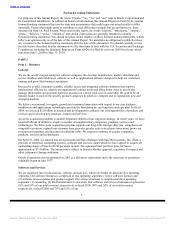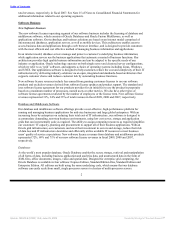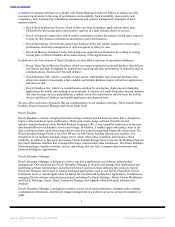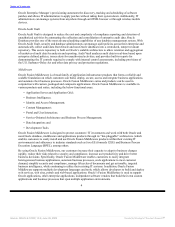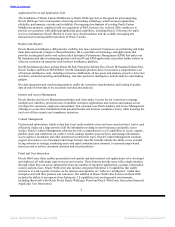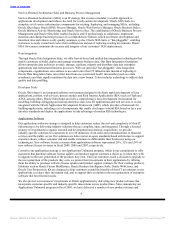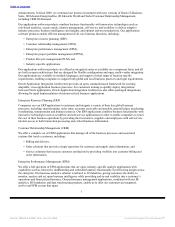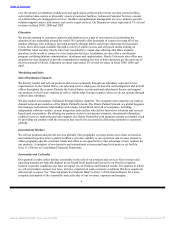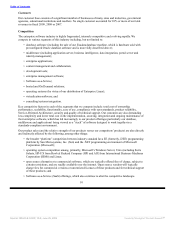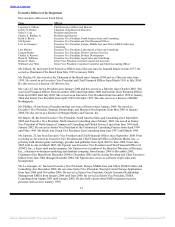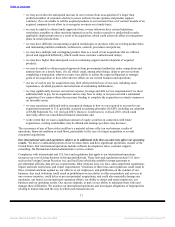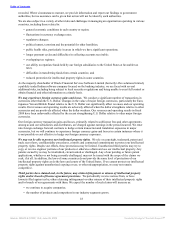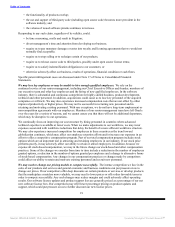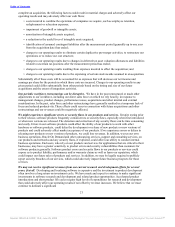Oracle 2008 Annual Report Download - page 16
Download and view the complete annual report
Please find page 16 of the 2008 Oracle annual report below. You can navigate through the pages in the report by either clicking on the pages listed below, or by using the keyword search tool below to find specific information within the annual report.
Table of Contents
The following lists of competitors are necessarily incomplete due to the nature of the enterprise software
industry, where the competitive landscape is constantly evolving as firms emerge, expand or are acquired, as
technology evolves and as customer demands and competitive pressures otherwise change:
In the sale of database software, scalability, reliability, availability and security are key competitive
differentiators for us. Our competitors include IBM, Microsoft, Sybase, Inc. (Sybase), NCR Corporation’s
Teradata division, SAS Institute, Inc., Netezza Corporation, Progress Software Corporation (Progress
Software) and open source databases such as Sun’s MySQL, Ingres and PostgreSQL, among others. Our
ability to continually innovate and differentiate our database product offerings has enabled us to maintain our
leading position in database software over our competitors.
In the sale of middleware products, our offerings include application server and application grid, business
intelligence, identity and access management, portal and user interaction, Service-Oriented Architecture and
business process management, and data integration. Our ability to offer a full range of rich functionality in a
standards-based, open architecture has been a key competitive differentiator which has contributed to rapid
growth of our middleware solutions in recent years relative to our competitors. Our middleware competitors
include IBM, Microsoft, SAP AG, Sun, Progress Software, Fujitsu Software Corporation, Hitachi Software
Engineering Co., Ltd., open source vendors such as Red Hat, Inc. (JBoss), Apache Geronimo, Liferay, Inc.,
SpringSource, Inc., MuleSource, Inc. and JasperSoft Corporation, as well as several other competitors in each
element of our packaged functions such as TIBCO Software, Inc., Software AG, SOA Software, Inc.,
Savvion, Inc., MicroStrategy, Inc., CA, Inc. (CA), Siemens AG, Courion Corporation, EMC Corporation
(RSA), Informatica Corporation, Novell, Inc. (Novell), Lombardi Software, Inc. and Pegasystems, Inc.,
among others.
Competition in the sale of applications software, in particular, is multifaceted and subject to rapid change. We
currently offer several application product lines that are designed to address functions applicable to customers
across many industries (e.g., enterprise resource planning (ERP) or customer relationship management
(CRM)), as well as applications specific to operations in particular industry verticals, such as retail, financial
services, communications, tax and utilities, health sciences, public sector and others. One of the main
competitive differentiators in applications software is our ability to combine “best-of-breed” software, suite
software and our application integration architecture, without adding complexity for the end user.
Our applications offerings (including our On Demand/Hosted and SaaS offerings) typically compete with
commercial software vendors’ pre-packaged applications, applications offered as On Demand, SaaS, or
hosted offerings, open source applications, applications developed in-house by customers, applications that
were custom developed by other software vendors or systems integrators, applications consisting of a variety
of discrete pieces of functionality from multiple providers that have been customized and implemented by
systems integrators or consultants (such as IBM Global Services and Accenture Ltd.) and business process
outsourcers (such as Automatic Data Processing, Inc. (ADP), Fidelity Investments, Ceridian Corporation,
Hewitt Associates, Inc., Accero Software (formerly Cyborg Systems Limited) and others). The variety of
competing offerings is even more pronounced in industry verticals where complete industry solutions either
do not exist or are addressed by combining offerings of multiple software offerings. As a result, our
applications compete against offerings from the vendors listed above as well as SAP AG, IBM (through
Maximo, MRO Software, Ascential Software, Cognos), Microsoft (through Dynamics GP, Dynamics NAV,
Dynamics AX, Dynamics CRM, Dynamics Snap, Dynamics SL), Lawson Software, Inc., Infor Global
Solutions (with numerous independent product lines coming from acquisitions including Agilisys, Baan, infor
GmbH, SSA Global Technologies, Extensity and Datastream), Ariba, Inc., IFS AB, JDA Software Group,
Inc., I2 Technologies, Inc., Manhattan Associates, Inc. The Sage Group plc, salesforce.com, Inc., Taleo
Corporation, SuccessFactors, Inc., as well as many other application providers and point solution providers.
In the sale of content management and collaboration products, we compete with Microsoft, IBM (through
Domino/Notes/FileNet), EMC Corporation (Documentum), Open Text Corporation, Autonomy Corporation
plc (Interwoven), HP (through Tower Software), SAP AG and Vignette Corporation, as well as open source
vendors such as Alfresco Software, Inc., among others.
In the sale of development tools, ease of use, standards-compliance and the level of abstraction (automated
code generation) are key competitive differentiators. In this area, we compete against IBM (through
WebSphere Studio), Microsoft (through VisualStudio.NET), Sun (through Sun Studio), Sybase (through
PowerBuilder) and others,
11
Source: ORACLE CORP, 10-K, June 29, 2009 Powered by Morningstar® Document Research℠


